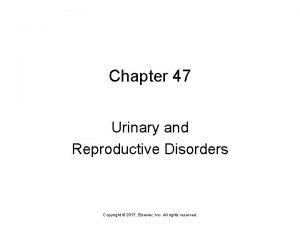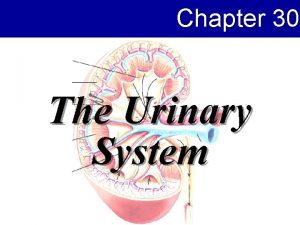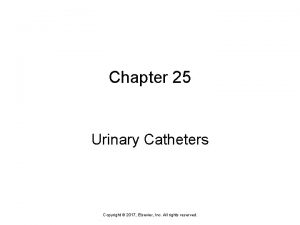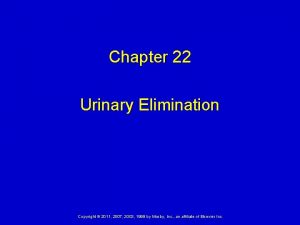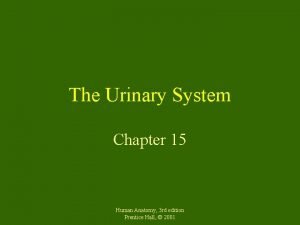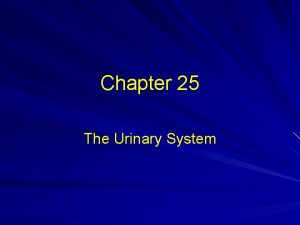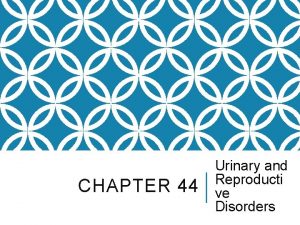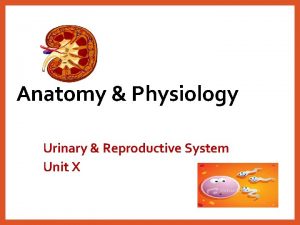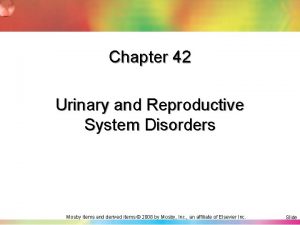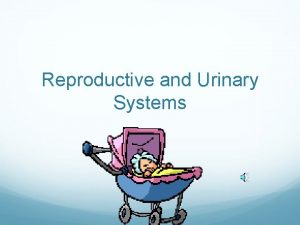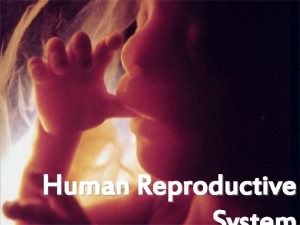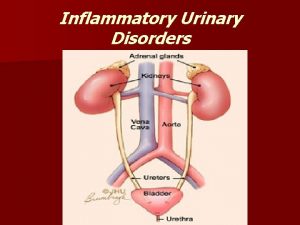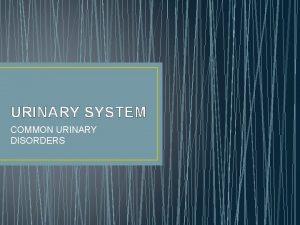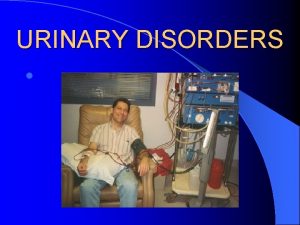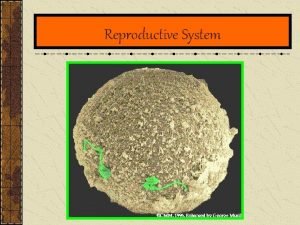Chapter 47 Urinary and Reproductive Disorders Copyright 2017



















- Slides: 19

Chapter 47 Urinary and Reproductive Disorders Copyright © 2017, Elsevier, Inc. All rights reserved.

Urinary and Reproductive Disorders Urinary and reproductive disorders are common. Understanding these disorders gives meaning to the required care. Ø Disorders can occur in these major urinary system structures. • The kidneys • Ureters • Bladder • Urethra Ø Men can develop prostate problems. Ø Copyright © 2017, Elsevier, Inc. All rights reserved. 2

Urinary System Disorders Ø Urinary tract infections (UTIs) • Infection in one area can progress through the entire system. • Microbes can enter the system through the urethra. • Common causes include: Catheterization Urological exams Intercourse Poor perineal hygiene Immobility Poor fluid intake • UTI is a common healthcare-associated infection. Copyright © 2017, Elsevier, Inc. All rights reserved. 3

Urinary System Disorders (Cont. ) • Women are at high risk. Microbes can easily enter the short female urethra. • Prostate gland secretions help protect men from UTIs. However, an enlarged prostate increases the risk of UTI. • Older persons are at high risk for UTIs. The following increase the risk: Incomplete bladder emptying Perineal soiling from fecal incontinence Poor fluid intake Poor nutrition Copyright © 2017, Elsevier, Inc. All rights reserved. 4

Urinary System Disorders (Cont. ) Ø Cystitis is a bladder infection caused by bacteria. • These signs and symptoms are common: Urinary frequency Oliguria (scant amount of urine) Urgency Dysuria (difficult or painful urination) Pain or burning on urination Foul-smelling urine Hematuria (blood in the urine) Pyuria (pus in the urine) Fever • Treatment includes antibiotics and encouraging fluids. Copyright © 2017, Elsevier, Inc. All rights reserved. 5

Urinary System Disorders (Cont. ) Ø Pyelonephritis is inflammation of the kidney pelvis. • Infection is the most common cause. • Cloudy urine may contain pus, mucus, and blood. • Signs and symptoms include Chills, fever, back pain Nausea and vomiting The signs and symptoms of cystitis • Treatment involves antibiotics and fluids. Copyright © 2017, Elsevier, Inc. All rights reserved. 6

Urinary System Disorders (Cont. ) Ø Prostate enlargement • The prostate is a gland in men. It lies in front of the rectum and just below the bladder. The prostate surrounds the urethra. • The prostate enlarges as the man grows older. This is called benign prostatic hyperplasia (BPH) or benign prostatic hypertrophy. • Bladder function is gradually lost. The enlarged prostate presses against the urethra, obstructing urine flow. Copyright © 2017, Elsevier, Inc. All rights reserved. 7

Urinary System Disorders (Cont. ) • The following problems are common with prostate enlargement: A weak urine stream Frequent voidings of small amounts of urine Urgency and leaking or dribbling of urine Frequent voiding at night Urinary retention • Treatment depends on the extent of the problem. The doctor may order drugs to shrink the prostate or stop its growth. Some microwave and laser treatments destroy excess prostate tissue. Transurethral resection of the prostate (TURP) is a common surgical procedure. Copyright © 2017, Elsevier, Inc. All rights reserved. 8

Urinary System Disorders (Cont. ) Ø Urinary diversions • Sometimes the bladder is surgically removed. Cancer and bladder injuries are common reasons. • Urinary diversion is a surgically created pathway for urine to leave the body. An ostomy is often involved. A urostomy is a surgically created opening between a ureter and the abdomen. – – A pouch is applied over the stoma. Urine drains through the stoma into the pouch. Pouches are changed every 5 to 7 days. A pouch is replaced anytime it leaks. Good skin care is needed. – Observe and report skin changes around the stoma. Copyright © 2017, Elsevier, Inc. All rights reserved. 9

Urinary System Disorders (Cont. ) Ø Kidney stones (calculi) • Most common in white men 40 years of age and older. • Risk factors include: Bedrest Immobility Poor fluid intake • Stones vary in size. Copyright © 2017, Elsevier, Inc. All rights reserved. 10

Urinary System Disorders (Cont. ) • Signs and symptoms include: Severe, cramping pain in the back and side just below the ribs Pain in the abdomen, thigh, and urethra Nausea and vomiting Fever and chills Dysuria (difficult or painful urination) Urinary urgency Burning on urination Hematuria (blood in the urine) Cloudy urine Foul-smelling urine Copyright © 2017, Elsevier, Inc. All rights reserved. 11

Urinary System Disorders (Cont. ) • Treatment involves: Drugs for pain relief Drinking 2000 to 3000 m. L of fluid a day All urine is strained. Medical or surgical removal of the stone may be necessary. • Some diet changes can prevent stones. Copyright © 2017, Elsevier, Inc. All rights reserved. 12

Urinary System Disorders (Cont. ) Ø Kidney failure (renal failure) • The kidneys do not function or are severely impaired. Waste products are not removed from the blood. Fluid is retained. – Heart failure and hypertension easily result. • It may be acute or chronic. Copyright © 2017, Elsevier, Inc. All rights reserved. 13

Urinary System Disorders (Cont. ) Ø Acute kidney failure is sudden. • Blood flow to the kidneys is severely decreased. • Causes include: Severe injury or bleeding Heart attack Heart failure Burns Infection Severe allergic reactions • Some persons develop chronic kidney failure. • Treatment involves drugs, restricted fluids, and diet therapy. Copyright © 2017, Elsevier, Inc. All rights reserved. 14

Urinary System Disorders (Cont. ) Ø Chronic kidney failure • The kidneys cannot meet the body’s needs. Nephrons in the kidney are destroyed over many years. • Common causes are: Hypertension Diabetes • Other causes include: Infections Urinary tract obstructions Tumors • Signs and symptoms appear when 75% of kidney function is lost. Copyright © 2017, Elsevier, Inc. All rights reserved. 15

Urinary System Disorders (Cont. ) • Treatment for chronic kidney failure includes: Fluid restriction Diet therapy Drugs Dialysis • Dialysis is the process of removing waste products from the blood. Hemodialysis removes waste and fluid by filtering the blood through an artificial kidney. Peritoneal dialysis uses the lining of the abdominal cavity (peritoneal membrane) to remove waste and fluid from the blood. Copyright © 2017, Elsevier, Inc. All rights reserved. 16

Reproductive Disorders Male reproductive system • Produces and transports sperm • Deposits sperm in the female reproductive tract • Secretes hormones Ø Female reproductive system • Produces eggs (ova) • Secretes hormones • Protects and nourishes the fetus during pregnancy Ø Aging, many injuries, diseases, and surgeries can affect reproductive structures and functions. Ø Copyright © 2017, Elsevier, Inc. All rights reserved. 17

Reproductive Disorders (Cont. ) Ø A sexually transmitted disease (STD) is spread by oral, vaginal, or anal sex. • Some people do not have signs and symptoms. • Some are not aware of an infection. • Others know but do not seek treatment because of embarrassment. Ø STDs occur in the: • Genital and rectal areas • Ears, mouth, nipples, throat, tongue, eyes, and nose Copyright © 2017, Elsevier, Inc. All rights reserved. 18

Reproductive Disorders (Cont. ) Ø Condom use helps prevent the spread of STDs. • Especially the human immunodeficiency virus (HIV) and acquired immunodeficiency syndrome (AIDS) Ø Some STDs are also spread through skin breaks, by contact with infected body fluids, or by contaminated blood or needles. • Standard Precautions and the Bloodborne Pathogen Standard are followed. Copyright © 2017, Elsevier, Inc. All rights reserved. 19
 Chapter 47 urinary and reproductive disorders
Chapter 47 urinary and reproductive disorders Chapter 17 reproductive system diseases and disorders
Chapter 17 reproductive system diseases and disorders Copyright secondary sara (2017) answers
Copyright secondary sara (2017) answers Figure 15-3 the urinary system
Figure 15-3 the urinary system Combining form for urinary bladder
Combining form for urinary bladder The urinary system chapter 30
The urinary system chapter 30 Chapter 22 urinary elimination
Chapter 22 urinary elimination Kidney pyramid labeled
Kidney pyramid labeled Chapter 25 urinary catheters
Chapter 25 urinary catheters Chapter 24 urinary elimination
Chapter 24 urinary elimination Chapter 22 urinary elimination
Chapter 22 urinary elimination Chapter 20 urinary/excretory system
Chapter 20 urinary/excretory system The urinary system chapter 15
The urinary system chapter 15 Chapter 9 the urinary system labeling exercises
Chapter 9 the urinary system labeling exercises Afferent arteriole and efferent arteriole
Afferent arteriole and efferent arteriole Retention hyperkeratosis dermnet
Retention hyperkeratosis dermnet Chapter 6 musculoskeletal system diseases and disorders
Chapter 6 musculoskeletal system diseases and disorders Chapter 46 digestive and endocrine disorders
Chapter 46 digestive and endocrine disorders Chapter 29 somatic symptom and dissociative disorders
Chapter 29 somatic symptom and dissociative disorders Chapter 29 endocrine and metabolic disorders
Chapter 29 endocrine and metabolic disorders
